 |
LOTUS SEVEN REGISTER |
the web site for the
Seven made by Lotus between 1957 and 1973
 |
LOTUS SEVEN REGISTER |
the web site for the
Seven made by Lotus between 1957 and 1973
LACK OF
DEMAND IN THE U.S:
By the
middle of 1958 four Sevens had been exported to the U.S., but the
Americans were not impressed with the Ford side-valve engine and
associated 3-speed gearbox offered with it. To them side-valve technology
was a thing of the 1930s and then a quarter of a century out of date and
whilst the handling characteristics were appreciated this did not outweigh
the fact and so there was no demand for the model.
THE FIRST
“A” SERIES POWERED SEVEN:
An
economical solution was found in the form of BMC’s Austin A35/Austin
Healey Sprite 948cc. “A” Series engine and Austin A30 aluminium cased
4-speed gearbox. Infact a Seven customer named Derek Harvey had installed
an “A” Series engine in his car a year earlier and this had been seen by
Lotus engineers when Derek visited the factory on completing the project.
THE SEVEN
“A”:
When they
came there were two BMC powered versions of the Seven. The first appeared
in August 1959 for the home market with an Austin A35 engine with single
H1 SU carburettor and was called the Lotus Seven “A”. Almost immediately,
this was followed by Daniel Richmond’s Downton tuning firm advertising a
version with more power.
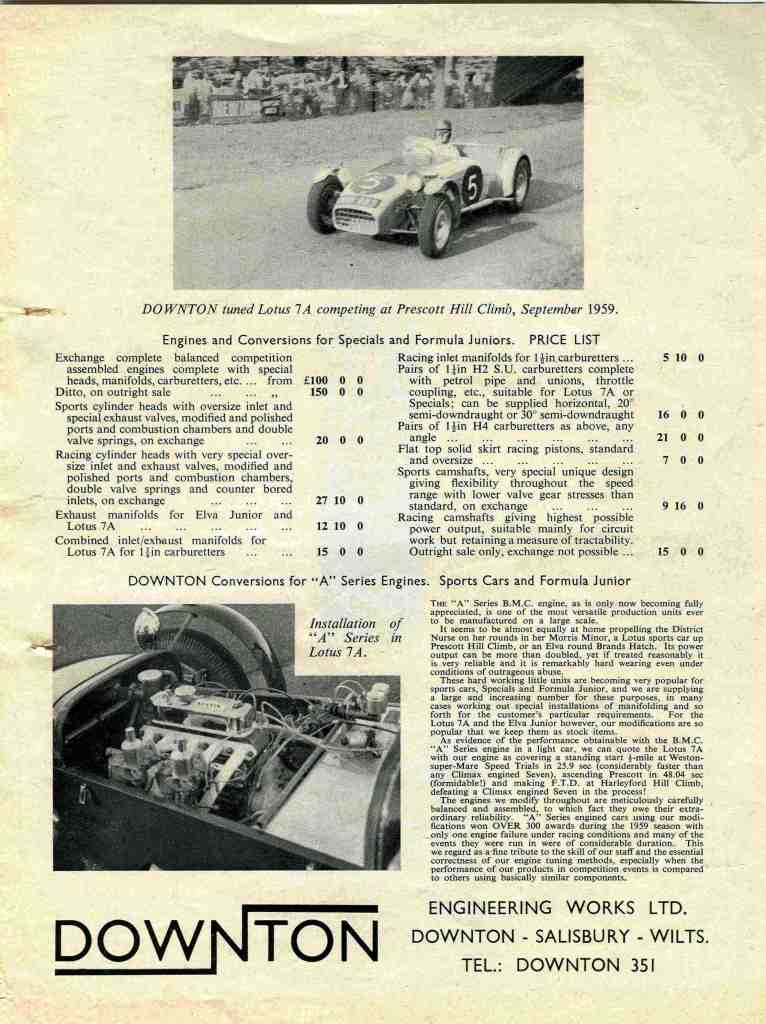 Downton Brochure for the Lotus 7A.
THE SEVEN
“AMERICA”:
In January
1960 Sports Car and Lotus Owner reported that “A prototype Lotus Seven
intended basically for the American market is undergoing extensive testing
at Cheshunt. Special equipment on this car includes flared glassfibre
front wings, a BMC “A” Series engine to Sprite specification, tubular
bumpers, winking indicators, a thermostatically-controlled electric
radiator fan and an Elite-type windscreen wiper motor. In April 1960 the
same magazine reported and pictured the Lotus Seven “America” at the Ford
Motor Company car show at Detroit. The same car was featured on the front
cover and in a road test report in the June 1960 issue of Sports Car
Illustrated.
Downton Brochure for the Lotus 7A.
THE SEVEN
“AMERICA”:
In January
1960 Sports Car and Lotus Owner reported that “A prototype Lotus Seven
intended basically for the American market is undergoing extensive testing
at Cheshunt. Special equipment on this car includes flared glassfibre
front wings, a BMC “A” Series engine to Sprite specification, tubular
bumpers, winking indicators, a thermostatically-controlled electric
radiator fan and an Elite-type windscreen wiper motor. In April 1960 the
same magazine reported and pictured the Lotus Seven “America” at the Ford
Motor Company car show at Detroit. The same car was featured on the front
cover and in a road test report in the June 1960 issue of Sports Car
Illustrated.
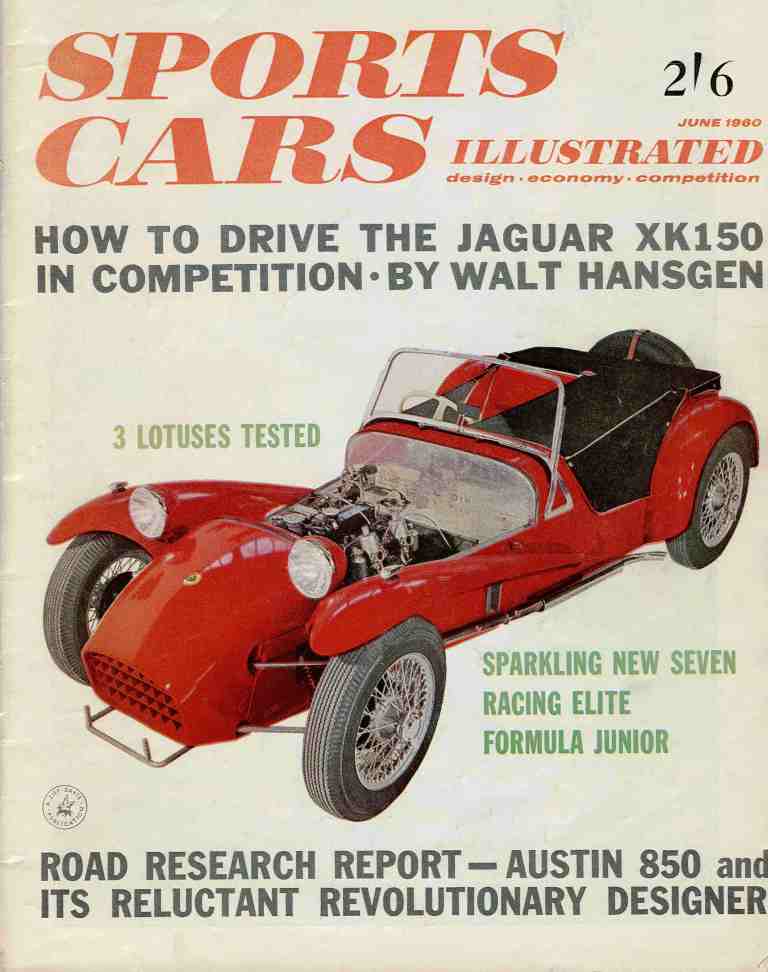 Front Cover Sports Cars Illustrated June 1960.
NEW MODEL
DESIGNATIONS:
Whilst
smaller in capacity than the old Ford iron, the BMC unit was up on power,
had good torque and good tuning potential. With the BMC powered car being
dubbed the Seven “A”, the continuing side-valve model was named the Seven
“F” and the Super Seven Climax version was re-dubbed the Seven “C”.
Front Cover Sports Cars Illustrated June 1960.
NEW MODEL
DESIGNATIONS:
Whilst
smaller in capacity than the old Ford iron, the BMC unit was up on power,
had good torque and good tuning potential. With the BMC powered car being
dubbed the Seven “A”, the continuing side-valve model was named the Seven
“F” and the Super Seven Climax version was re-dubbed the Seven “C”.
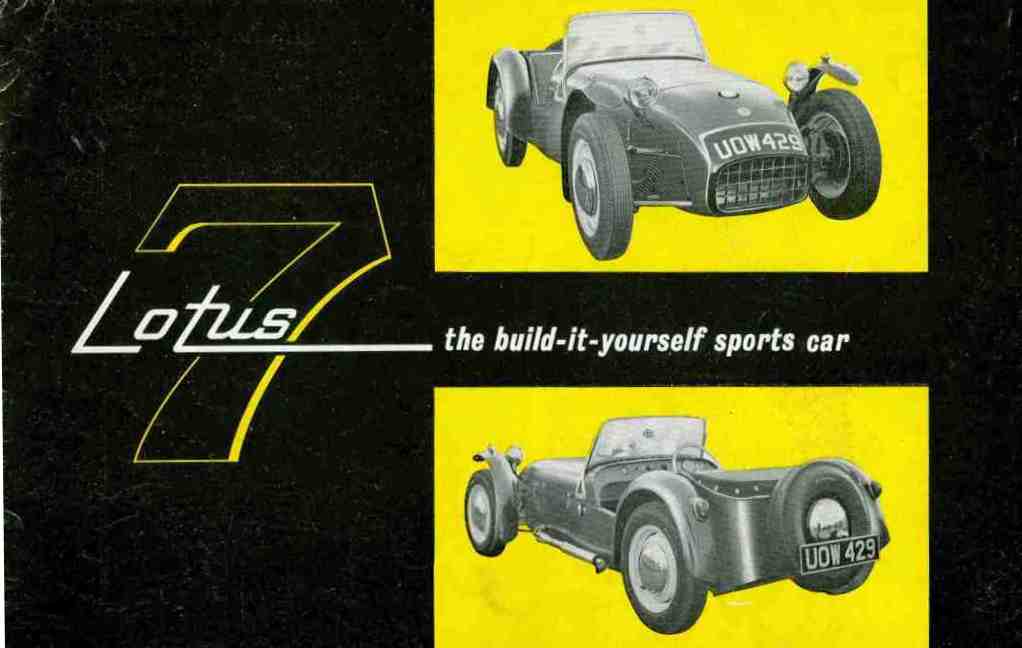 Front of third Lotus Seven
Brochure.
CHANGES TO
THE CHASSIS:
Installation
of the engine/gearbox combination required changes to the body chassis
unit: Firstly the “A” Series 4-speed gearbox was somewhat larger than the
old Ford 3-speeder and a ½” x ½” vertical member had to be moved over,
narrowing the footwell a little. All the Hornsey cars had bottom mounted
clutch and brake pedals with the clutch operating directly off the
actuating arm by way of a link rod. The new Cheshunt-built cars had
pendant pedals with master cylinders for both clutch and brakes above the
footwell. Lastly to comply with U.S. requirements John Frayling and Peter
Kirwan-Taylor designed long flowing front wings for the “America” model
dubbed “Clamshell” wings. These replaced the static cycle wings which were
not approved of in some states.
LOTUS MOVE
TO CHESHUNT:
By 1958
Lotus were bulging at the seams at the little Hornsey works. Already work
to the Elite was being carried on elsewhere. With the Elite, the Fifteen
and Sixteen Formula car and the Seven, it was only a matter of time before
the move came. When it did it was to a new purpose made two unit factory
premises in Delamare Road, Cheshunt just up the A10 from Hornsey in
Hertfordshire. Operations were moved to the new factory in July 1959 and
the premises was officially opened on 14th October with many
dignatories attending on the day. Lotus Seven kits were produced in the
first floor area above the formula car production area, the chassis frames
being lifted via a gantry at the front.
Front of third Lotus Seven
Brochure.
CHANGES TO
THE CHASSIS:
Installation
of the engine/gearbox combination required changes to the body chassis
unit: Firstly the “A” Series 4-speed gearbox was somewhat larger than the
old Ford 3-speeder and a ½” x ½” vertical member had to be moved over,
narrowing the footwell a little. All the Hornsey cars had bottom mounted
clutch and brake pedals with the clutch operating directly off the
actuating arm by way of a link rod. The new Cheshunt-built cars had
pendant pedals with master cylinders for both clutch and brakes above the
footwell. Lastly to comply with U.S. requirements John Frayling and Peter
Kirwan-Taylor designed long flowing front wings for the “America” model
dubbed “Clamshell” wings. These replaced the static cycle wings which were
not approved of in some states.
LOTUS MOVE
TO CHESHUNT:
By 1958
Lotus were bulging at the seams at the little Hornsey works. Already work
to the Elite was being carried on elsewhere. With the Elite, the Fifteen
and Sixteen Formula car and the Seven, it was only a matter of time before
the move came. When it did it was to a new purpose made two unit factory
premises in Delamare Road, Cheshunt just up the A10 from Hornsey in
Hertfordshire. Operations were moved to the new factory in July 1959 and
the premises was officially opened on 14th October with many
dignatories attending on the day. Lotus Seven kits were produced in the
first floor area above the formula car production area, the chassis frames
being lifted via a gantry at the front.
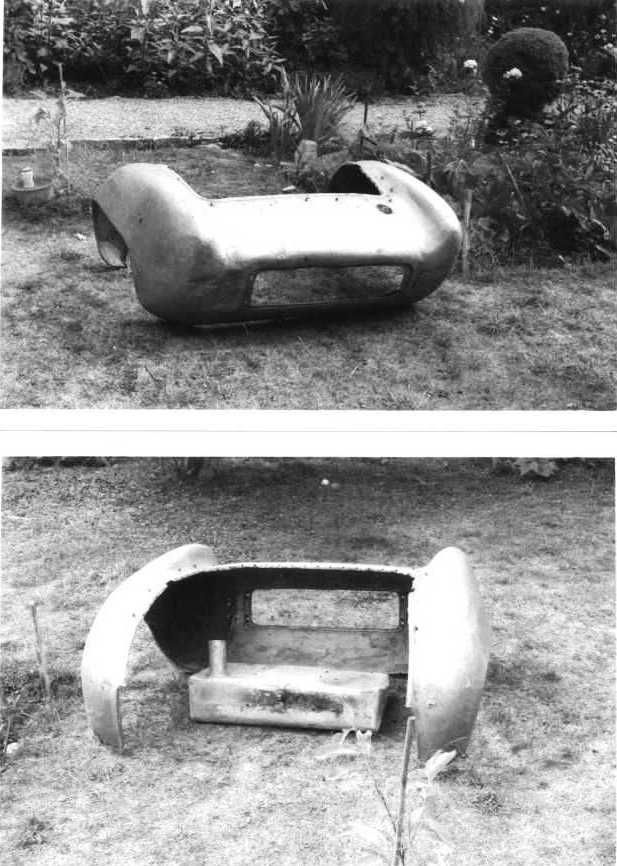 Lotus Seven Eleven body
panels.
THE LOTUS 7
½:
As always
the race track brought out new ideas for the Seven. Not all of these were
generated officially by the factory. One of the more famous unofficial
cars was called the Lotus 7 ½ or the Lotus 7/20. David Porter had rolled
his Seven around Paddock Bend when racing at Brands Hatch. He had
previously been at engineering college with Hugh Haskell who had become a
project engineer at Lotus. The damage to the car meant that most of the
suspension and running gear had to be replaced and Hugh suggested that
they might go all-independent using parts from the Formula Junior Lotus 20
and installing a modified Ford Anglia engine by tuners, Cosworth. The
project, although unofficial, had Colin Chapman’s blessing and when
completed he was one of its drivers at the Six Hour Race at Silverstone
1962. The car was very successful in the hands of David Porter and
co-owners, Keith and Wendy Hamblin for two seasons and then for a further
three seasons with Natalie Goodwin. It was then sold to the U.S.A. and
then on the Japan where it is believed to be today. The 7/20 was the first
Seven with full I.R.S and was the fore-runner of the Lotus Three-7 I.R.S.
clubmans car of 1965.
Lotus Seven Eleven body
panels.
THE LOTUS 7
½:
As always
the race track brought out new ideas for the Seven. Not all of these were
generated officially by the factory. One of the more famous unofficial
cars was called the Lotus 7 ½ or the Lotus 7/20. David Porter had rolled
his Seven around Paddock Bend when racing at Brands Hatch. He had
previously been at engineering college with Hugh Haskell who had become a
project engineer at Lotus. The damage to the car meant that most of the
suspension and running gear had to be replaced and Hugh suggested that
they might go all-independent using parts from the Formula Junior Lotus 20
and installing a modified Ford Anglia engine by tuners, Cosworth. The
project, although unofficial, had Colin Chapman’s blessing and when
completed he was one of its drivers at the Six Hour Race at Silverstone
1962. The car was very successful in the hands of David Porter and
co-owners, Keith and Wendy Hamblin for two seasons and then for a further
three seasons with Natalie Goodwin. It was then sold to the U.S.A. and
then on the Japan where it is believed to be today. The 7/20 was the first
Seven with full I.R.S and was the fore-runner of the Lotus Three-7 I.R.S.
clubmans car of 1965.
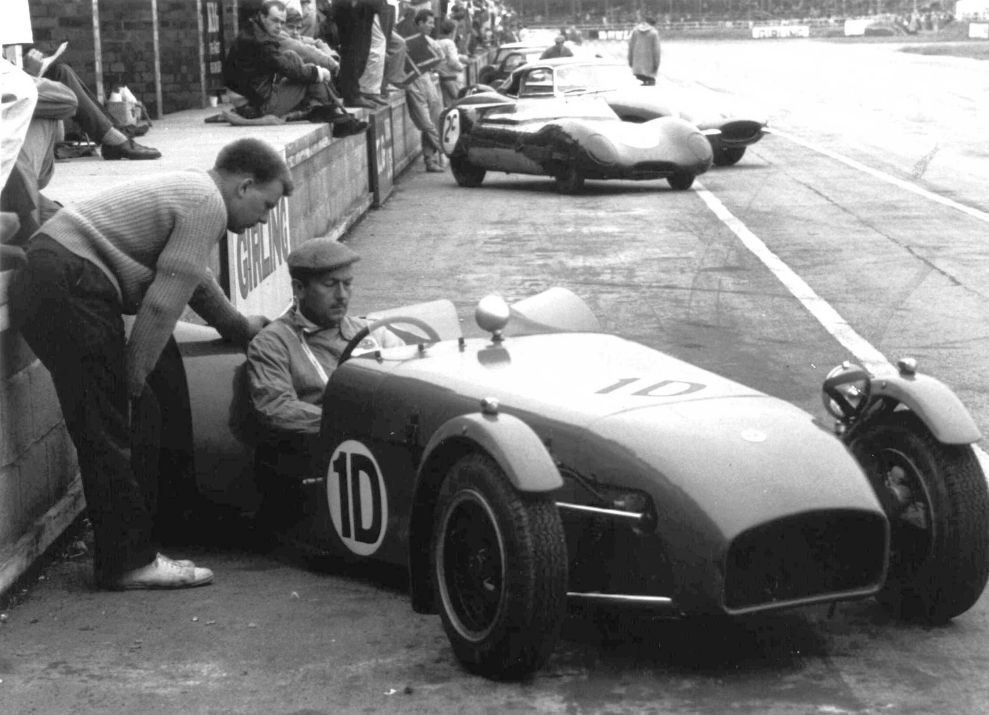 Colin Chapman at the wheel of
the Lotus 7 1/2 at the Six Hour Race 1962.
Photographs
by courtesy of:-
Ferret
Fotographics TEL: 01453-543243
Tony Bates
Sources and
further reading:
Lotus Seven
by Jeremy Coulter (198?)
Lotus – All
the Cars by Anthony Pritchard (1990)
The Lotus
Book by William Taylor (1998)
JWW
Colin Chapman at the wheel of
the Lotus 7 1/2 at the Six Hour Race 1962.
Photographs
by courtesy of:-
Ferret
Fotographics TEL: 01453-543243
Tony Bates
Sources and
further reading:
Lotus Seven
by Jeremy Coulter (198?)
Lotus – All
the Cars by Anthony Pritchard (1990)
The Lotus
Book by William Taylor (1998)
JWW
|
| [previous chapter] [next chapter] [back to menu] |